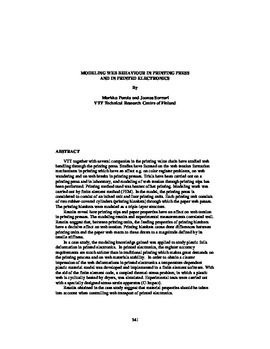| dc.contributor.author | Parola, Markku | |
| dc.contributor.author | Sorvari, Joonas | |
| dc.contributor.other | International Conference on Web Handling (2013) | |
| dc.date.accessioned | 2019-11-12T14:57:33Z | |
| dc.date.available | 2019-11-12T14:57:33Z | |
| dc.date.issued | 2013-06 | |
| dc.identifier | oksd_icwh_2013_parola | |
| dc.identifier.citation | Parola, M., & Sorvari, J. (2013, June). Modeling web behaviour in printing press and in printed electronics. Paper presented at the Twelfth International Conference on Web Handling (IWEB), Stillwater, OK. | |
| dc.identifier.uri | https://hdl.handle.net/11244/322006 | |
| dc.description.abstract | VTT together with several companies in the printing value chain have studied web handling through the printing press. Studies have focused on the web tension formation mechanisms in printing which have an effect e.g. on color register problems, on web wandering and on web breaks in printing presses. Trials have been carried out on a printing press and in laboratory, and modeling of web tension through printing nips has been performed. Printing method used was heatset offset printing. Modeling work was carried out by finite element method (FEM). In the model, the printing press is considered to consist of an infeed unit and four printing units. Each printing unit consists of two rubber-covered cylinders (printing blankets) through which the paper web passes. The printing blankets were modeled as a triple-layer structure. | |
| dc.description.abstract | Results reveal how printing nips and paper properties have an effect on web tension in printing presses. The modeling results and experimental measurements correlated well. Results suggest that, between printing units, the feeding properties of printing blankets have a decisive effect on web tension. Printing blankets cause draw differences between printing units and the paper web reacts to these draws to a magnitude defined by its tensile stiffness. | |
| dc.description.abstract | In a case study, the modeling knowledge gained was applied to study plastic foils deformation in printed electronics. In printed electronics, the register accuracy requirements are much stricter than in traditional printing which makes great demands on the printing process and on web materials stability. In order to obtain a clearer impression of the web deformations in printed electronics a temperature-dependent plastic material model was developed and implemented in a finite element software. With the aid of the finite element code, a coupled thermal-stress problem, in which a plastic web is cyclically heated by dryers, was simulated. Experimental tests were carried out with a specially designed stress-strain apparatus (C-Impact). | |
| dc.description.abstract | Results obtained in the case study suggest that material properties should be taken into account when controlling web transport of printed electronics. | |
| dc.format | application/pdf | |
| dc.language | en_US | |
| dc.publisher | Oklahoma State University | |
| dc.rights | In the Oklahoma State University Library's institutional repository this paper is made available through the open access principles and the terms of agreement/consent between the author(s) and the publisher. The permission policy on the use, reproduction or distribution of the article falls under fair use for educational, scholarship, and research purposes. Contact Digital Resources and Discovery Services at lib-dls@okstate.edu or 405-744-9161 for further information. | |
| dc.title | Modeling web behaviour in printing press and in printed electronics | |
| osu.filename | oksd_icwh_2013_parola.pdf | |
| dc.type.genre | Conference proceedings | |
| dc.type.material | Text | |
